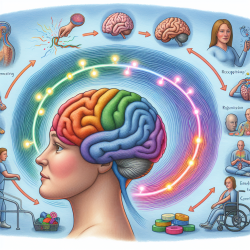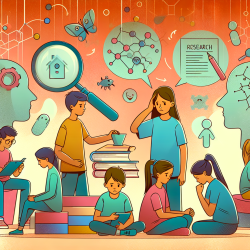Introduction
As practitioners in the field of speech-language pathology, understanding the intricate relationship between brain injury and emotion regulation can significantly enhance therapeutic outcomes. The study titled "Reappraisal generation after acquired brain damage: The role of laterality and cognitive control" provides valuable insights into how brain injuries affect the ability to generate positive reinterpretations of negative events, known as reappraisal. This blog explores the findings of this research and offers guidance on how practitioners can apply these insights to improve their practice.
Understanding Reappraisal and Its Importance
Reappraisal is a cognitive emotion regulation strategy that involves changing the way one thinks about a situation to alter its emotional impact. This ability is crucial for emotional adjustment and social functioning, especially for individuals with brain injuries. The study investigated whether individuals with left hemisphere (LH) damage are more impaired in generating reappraisals compared to those with right hemisphere (RH) damage and healthy controls.
Key Findings
- Reappraisal difficulty, measured by the time taken to generate a first reappraisal, was similar between LH and RH groups but significantly higher than healthy controls.
- No significant differences in reappraisal productivity were observed across groups, indicating that brain-injured individuals can generate reappraisals as effectively as healthy individuals when time constraints are removed.
- Inhibition and verbal fluency were inversely related to reappraisal difficulty, highlighting their role in reappraisal generation.
Implications for Practice
Practitioners can leverage these findings to enhance therapeutic interventions for individuals with brain injuries:
- Focus on Cognitive Control: Incorporate exercises that enhance inhibition and verbal fluency, as these are crucial for reducing reappraisal difficulty.
- Allow Adequate Time: Provide sufficient time for clients to generate reappraisals, acknowledging that they may require more time than individuals without brain injuries.
- Tailored Interventions: Customize interventions based on the specific cognitive control deficits observed in each client, focusing on strengthening these areas.
Encouraging Further Research
The study opens avenues for further exploration into the neuropsychological components of reappraisal generation. Practitioners are encouraged to engage in research that examines the impact of targeted cognitive control interventions on reappraisal abilities in brain-injured populations.
Conclusion
Understanding the neuropsychological underpinnings of reappraisal generation can empower practitioners to design more effective interventions for individuals with brain injuries. By focusing on cognitive control processes and allowing adequate time for reappraisal, practitioners can significantly enhance the emotional regulation capabilities of their clients.
To read the original research paper, please follow this link: Reappraisal generation after acquired brain damage: The role of laterality and cognitive control.










